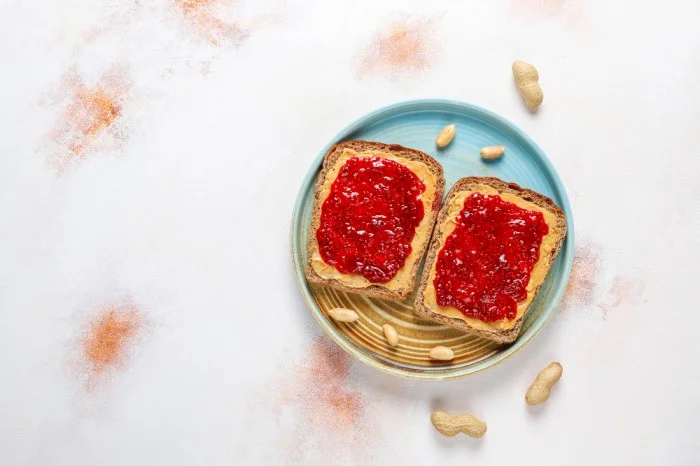Have you ever wondered if one of childhood’s simplest pleasures—the peanut butter and jelly sandwich—could actually form the foundation of a diet? It sounds almost too good to be true. Yet, in nutrition circles, this humble classic has sparked surprising debates about balance, convenience, and whether it can be part of a long-term healthy lifestyle. As a healthcare-focused team at Cure on Call, we decided to explore the evidence, test it ourselves, and consult dietitians to give you an honest, expert-backed breakdown.
Why the Peanut Butter and Jelly Sandwich Deserves a Second Look
Most people think of peanut butter and jelly as a sugary childhood snack, hardly fit for serious nutrition. But let’s break it down:
- Peanut butter provides protein, healthy fats, and fibre.
- Jelly (or jam) contributes quick energy (sugar), though quality matters—fruit-based spreads with less added sugar are far better.
- Whole-grain bread adds complex carbs, fibre, and essential micronutrients.
When combined, this trio forms a surprisingly well-rounded macronutrient profile: carbs for energy, protein for muscle repair, and fats for satiety.
Dr. Laura Smith, a registered dietitian at King’s College London, puts it simply:
“It’s not the sandwich itself that’s unhealthy—it’s the choices around it. Opt for wholegrain bread, natural peanut butter, and reduced-sugar jam, and you’ve got a nutrient-dense meal.”
Personal Experiment: A Week on the PB&J Diet
To avoid theory alone, I (writing as part of Cure on Call) tested this diet for a week. My goal wasn’t to eat only peanut butter and jelly sandwiches, but to make them the core meal once per day and see how it affected my energy, satiety, and overall health.
What I Noticed:
- Day 1–2: Felt nostalgic and oddly energised, but also slightly guilty about eating “kids’ food.”
- Day 3–5: Cravings were surprisingly low. Peanut butter’s satiety helped me avoid unnecessary snacking.
- Day 6–7: I began to miss variety. While nutritionally balanced, the monotony made me crave vegetables and fresh textures.
Lesson learned? A PB&J can absolutely anchor a diet, but it shouldn’t dominate it without complementary foods.
The Science Behind Peanut Butter & Jelly
Protein & Muscle Support
Peanut butter typically contains 7–8g of protein per two tablespoons. Combined with wholegrain bread, this supports muscle repair and growth. A study in the Journal of Nutrition (2019) highlighted that nut butters contribute significantly to daily protein intake when used regularly.
Healthy Fats for Brain Function
Natural peanut butter is rich in monounsaturated fats, linked to improved cardiovascular health and cognitive function (Harvard T.H. Chan School of Public Health).
Sugar: The Sticky Problem
Where PB&J diets falter is with jelly. A typical store-bought jelly contains 10–12g of added sugar per tablespoon. That’s why choosing fruit-based spreads or making your own from berries is crucial.
Satiety and Weight Management
A small 2020 clinical trial found that nut butter consumption was associated with reduced hunger levels and better portion control throughout the day.
How to Make a PB&J Sandwich Healthier
If you’re considering incorporating PB&Js into your diet, here are some expert-approved tips:
- Choose wholegrain or seeded bread → Higher fibre improves digestion and satiety.
- Opt for natural peanut butter → Look for ingredients lists with just peanuts and maybe salt.
- Pick low-sugar or fruit-only jams → Freshly made berry compotes can cut sugar dramatically.
- Mind the portion size → A single sandwich can pack 350–400 calories.
Can You Really Build a Diet Around PB&Js?
Short answer: yes, but with conditions. The peanut butter and jelly sandwich can form part of a balanced diet if:
- You rotate it with other nutrient-dense meals.
- You balance it with fresh vegetables, lean proteins, and whole fruits.
- You stay mindful of sugar intake from jelly.
Think of PB&J as a nutritional anchor—simple, filling, and energising—but not a complete dietary solution.
Sample PB&J Diet Plan (Balanced Version)
- Breakfast: Greek yoghurt with berries and honey.
- Lunch: Peanut butter and jelly sandwich on wholegrain bread + side salad.
- Snack: Carrot sticks with hummus.
- Dinner: Grilled salmon, quinoa, and steamed vegetables.
This approach allows PB&J to shine without compromising variety or micronutrient needs.
FAQs
Is the PB&J diet good for weight loss?
Yes, but only if you watch calorie intake. Peanut butter is calorie-dense, so moderation is key.
Is it safe for diabetics?
It depends on bread and jam choices. Wholegrain bread and sugar-free spreads are far better suited.
Can athletes benefit from PB&Js?
Absolutely. The carb-protein-fat ratio makes it an excellent pre- or post-workout snack.
How often should I eat PB&Js?
1 sandwich daily is reasonable for most adults, provided other meals offer variety.
What’s the healthiest jam option?
Fruit-only spreads or homemade compotes with minimal added sugar.
Final Thoughts: Nostalgia Meets Nutrition
So, can the peanut butter and jelly sandwich diet really work? The answer isn’t black or white. On its own, it lacks the diversity required for complete nutrition. But as part of a balanced approach, it can be surprisingly effective, affordable, and—let’s be honest—delicious.
If you’ve ever felt guilty about enjoying a PB&J, you can let that go. The science shows that, with smart choices, it’s more than just childhood comfort food—it’s a practical, energising addition to a modern diet.
Your turn: Would you try incorporating PB&Js into your daily diet? If so, what swaps or tweaks would you make? Share your thoughts in the comments—we’d love to hear from you.
Read Also:Best 4500 Calorie Diet Plan – A Complete Guide by Cure On Call




